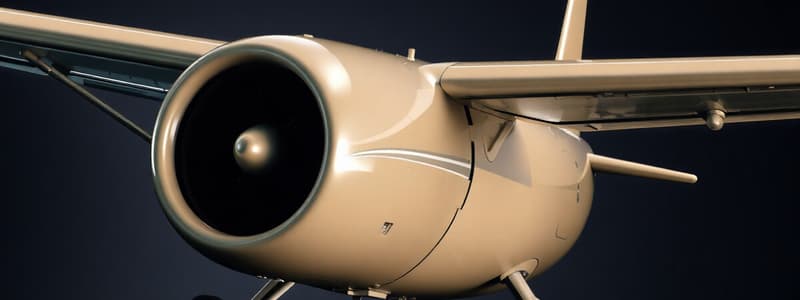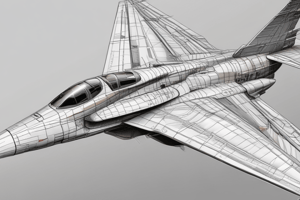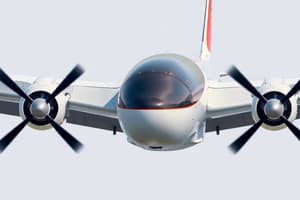Podcast
Questions and Answers
What is the primary upward force that supports an aeroplane in flight?
What is the primary upward force that supports an aeroplane in flight?
- Lift (correct)
- Weight
- Thrust
- Drag
Which force opposes lift and is caused by the pull of gravity on the aircraft?
Which force opposes lift and is caused by the pull of gravity on the aircraft?
- Lift
- Weight (correct)
- Drag
- Thrust
What type of force propels the aeroplane forward through the air?
What type of force propels the aeroplane forward through the air?
- Drag
- Weight
- Lift
- Thrust (correct)
Which force limits the speed of the aeroplane and opposes thrust?
Which force limits the speed of the aeroplane and opposes thrust?
What control surfaces on the wing are responsible for controlling the roll of the aeroplane?
What control surfaces on the wing are responsible for controlling the roll of the aeroplane?
Which part of the aircraft is primarily responsible for controlling its pitch?
Which part of the aircraft is primarily responsible for controlling its pitch?
What term describes the body of an aeroplane?
What term describes the body of an aeroplane?
Which of the following describes the axes around which an aircraft can rotate?
Which of the following describes the axes around which an aircraft can rotate?
What is the lateral axis in an aircraft?
What is the lateral axis in an aircraft?
Which force opposes the weight of an aircraft?
Which force opposes the weight of an aircraft?
What happens when the centre of gravity is too far forward?
What happens when the centre of gravity is too far forward?
What is the definition of lift in aviation?
What is the definition of lift in aviation?
How is the center of gravity crucial to aircraft stability?
How is the center of gravity crucial to aircraft stability?
Which type of axis is responsible for yawing motion in an aircraft?
Which type of axis is responsible for yawing motion in an aircraft?
What occurs during straight-and-level flight?
What occurs during straight-and-level flight?
What is increased if the aircraft's center of gravity shifts excessively aft?
What is increased if the aircraft's center of gravity shifts excessively aft?
What is the main role of the centre of pressure in flight dynamics?
What is the main role of the centre of pressure in flight dynamics?
Which consequence can occur as a result of an adverse aft center of gravity?
Which consequence can occur as a result of an adverse aft center of gravity?
What happens when the angle of attack increases?
What happens when the angle of attack increases?
What role does thrust play in changing the aircraft's flight state?
What role does thrust play in changing the aircraft's flight state?
In the context of an aircraft, what does drag represent?
In the context of an aircraft, what does drag represent?
Which of the following describes the ideal arrangement of aerodynamic forces?
Which of the following describes the ideal arrangement of aerodynamic forces?
What initial action is taken to begin a climb?
What initial action is taken to begin a climb?
During a climb, what happens to the airspeed if no change in power setting is made?
During a climb, what happens to the airspeed if no change in power setting is made?
What must happen for the aircraft to be in a vertical climb?
What must happen for the aircraft to be in a vertical climb?
What force is largely responsible for pulling the aircraft down during a descent?
What force is largely responsible for pulling the aircraft down during a descent?
In a steady glide, how do lift and drag relate to the aircraft's weight?
In a steady glide, how do lift and drag relate to the aircraft's weight?
Which angle of attack produces the best lift/drag ratio during a glide?
Which angle of attack produces the best lift/drag ratio during a glide?
Which statement about glide speed is correct?
Which statement about glide speed is correct?
How is the glide ratio defined?
How is the glide ratio defined?
What does the tangent of the glide angle represent?
What does the tangent of the glide angle represent?
What term is used to describe the force that pulls an object outward in a circular path?
What term is used to describe the force that pulls an object outward in a circular path?
What must happen to keep a body in circular motion according to Newton’s First Law?
What must happen to keep a body in circular motion according to Newton’s First Law?
What effect does increasing the angle of climb have on lift?
What effect does increasing the angle of climb have on lift?
Which force is greater in a steady climb?
Which force is greater in a steady climb?
What must an airplane overcome before it can initiate a turn?
What must an airplane overcome before it can initiate a turn?
Which component of lift acts horizontally during a turn?
Which component of lift acts horizontally during a turn?
What happens during a sideslip in an airplane?
What happens during a sideslip in an airplane?
When an airplane skids outwards, what causes this phenomenon?
When an airplane skids outwards, what causes this phenomenon?
What defines wing loading?
What defines wing loading?
How does increased weight affect an aircraft's minimum speed?
How does increased weight affect an aircraft's minimum speed?
What does the load factor of an aircraft indicate?
What does the load factor of an aircraft indicate?
What is the main purpose of trailing edge flaps on an aircraft?
What is the main purpose of trailing edge flaps on an aircraft?
During a normal turn, the load factor is typically:
During a normal turn, the load factor is typically:
What do leading edge slats accomplish for an aircraft?
What do leading edge slats accomplish for an aircraft?
Which of the following devices is considered a high-lift device?
Which of the following devices is considered a high-lift device?
How do leading edge slots help prevent stalls in aircraft?
How do leading edge slots help prevent stalls in aircraft?
What effect does load factor have on stall speed during a turn?
What effect does load factor have on stall speed during a turn?
What happens to lift and drag when flaps or slats are fully lowered?
What happens to lift and drag when flaps or slats are fully lowered?
What is the relationship between bank angle and load factor?
What is the relationship between bank angle and load factor?
What is a characteristic of slats on an aircraft?
What is a characteristic of slats on an aircraft?
Which of the following is not a type of high-lift device?
Which of the following is not a type of high-lift device?
In what phase of flight is the ability to fly slowly particularly essential?
In what phase of flight is the ability to fly slowly particularly essential?
Which situation could create a negative load factor?
Which situation could create a negative load factor?
What effect do partial flaps/slats have when extended during take-off?
What effect do partial flaps/slats have when extended during take-off?
What occurs when opposing forces during a turn are balanced?
What occurs when opposing forces during a turn are balanced?
What is the relationship between angle of attack and stall occurrences?
What is the relationship between angle of attack and stall occurrences?
What is generally used to measure the imposed load factor during flight?
What is generally used to measure the imposed load factor during flight?
Flashcards are hidden until you start studying
Study Notes
Aerodynamics of Flight
- Four forces act on an aircraft during flight: lift, weight, thrust, drag.
- Lift: Upward force created by airflow over and under the wings. Acts at a right angle to the airflow through the Centre of Pressure (C of P).
- Weight: Downward force caused by gravity. Acts through the Centre of Gravity (C of G).
- Thrust: Forward force that propels the aircraft through the air. Acts through the centreline of the engine or propeller.
- Drag: Backward force that opposes thrust. Acts at a right angle to lift.
Aircraft Components
- Fuselage: The body of the aircraft.
- Wings: Horizontal aerofoils producing lift. Ailerons and flaps are hinged to the wings.
- Tail: Provides stability and control.
- Engine: Provides thrust.
Primary Flight Controls
- Ailerons: Control roll by moving up or down, creating a rolling moment.
- Elevator: Controls pitch by moving up or down, creating a pitching moment.
- Rudder: Controls yaw by moving left or right, creating a yawing moment.
Aircraft Axes
- Lateral Axis: Extends wing tip to wing tip, rotation around this axis is called pitch.
- Longitudinal Axis: Extends nose to tail, rotation around this axis is called roll.
- Vertical Axis: Passes vertically through the centre of gravity, rotation around this axis is called yaw.
Lift and Weight
- Key aerodynamic forces are lift and weight.
- Lift opposes weight.
- In straight and level flight, lift and weight are equal.
- The shape of the wing creates high pressure under the wing and low pressure above, generating lift.
Centre of Gravity (CG) and Centre of Pressure (CP)
- Centre of Gravity (CG) is the point where the aircraft's weight is concentrated.
- Centre of Pressure (CP) is the point where the lift force acts.
- The designer carefully positions the CG relative to the CP to maintain stability.
- Ideal arrangement: CG forward of CP, thrust line lower than drag, creating opposing forces that balance.
Adverse Forward Centre of Gravity
Occurs when too much weight is towards the front of the aircraft.
- Increased fuel consumption.
- Increased power required.
- Increased tendency to dive, especially with power off.
- Increased oscillation tendency.
- Increased stress on the nose wheel.
- Increased danger during flap operation.
- Difficult to raise the nose during landing.
Adverse Aft Centre of Gravity
Occurs when too much weight is towards the tail of the aircraft.
- Poor stability.
- Reduced flying speed.
- Reduced range.
- Increased strain on the pilot during instrument flight.
- Increased danger of stall.
- Dangerous spin characteristics.
- Poor landing characteristics.
Centre of Gravity Limits
- Every aircraft type has its own CG limits, usually between 15% and 40% of the wing chord.
- Limits are established by design based on flight handling characteristics.
Straight-and-Level Flight
- In straight and level flight at a constant airspeed, Lift = Weight, and Thrust = Drag.
- To change equilibrium, use thrust to accelerate or climb, reduce thrust to descend.
Forces in a Climb
- When entering a climb, lift momentarily increases as the nose is raised.
- Airspeed gradually decreases as thrust is insufficient to counter the increased drag during a climb.
- More power is required to maintain a constant airspeed during a climb than in level flight.
Forces in a Descent
- Entering a descent decreases angle of attack, momentarily decreasing lift.
- Weight becomes greater than lift, causing the aircraft to descend.
- Thrust is reduced to allow gravity to pull the aircraft downwards.
Forces in a Glide
- Thrust is removed, lift and drag balance the weight.
- Best glide ratio is achieved at an angle of attack that produces the maximum lift/drag ratio.
Glide Ratio and Glide Angle
- Glide Ratio: Distance travelled divided by altitude descended.
- Glide Angle: The angle of the glide path, calculated using the tangent of the angle.
Theory of the Turn
- Centrifugal Force: The outward force experienced by a body moving in a curved path.
- Centripetal Force: The inward force that counters centrifugal force, keeping the body in a curved path.
- An aeroplane banks to turn, generating a horizontal component of lift (centripetal force) that pulls the aircraft towards the centre of the turn.
Sideslip, Skidding and Balanced Turn
- Sideslip: Occurs when the bank angle is too high, causing the aircraft to drift inwards during the turn - Skidding: Occurs when the bank angle is too low, causing the aircraft to drift outwards during the turn.
- Balanced Turn: Occurs when the bank angle is correct, with no sideways drift during the turn.
Wing Loading
- Wing loading is the weight of the aircraft divided by the wing area.
- Measured in pounds per square foot (lb/ft2) or kilograms per square metre (kg/m2).
- A lower wing loading results in a lower stall speed.
- A higher wing loading results in a higher stall speed.
Load Factor
- Load factor is the ratio of the load imposed on the aircraft structure to the weight of the structure itself.
- Measured in g (gravity units).
- In straight and level flight, the load factor is 1g.
- Aircraft are designed to withstand load factors greater than 1g during maneuvers and turbulence.
Load Factor Limits
- Each aircraft has a specified g limit to avoid structural damage.
- Certification standards ensure adequate strength to withstand load factors.
Effect of Load Factor on Stall Speed
- Increasing load factor narrows the safety margin above stall.
- The aircraft is closer to its stalling angle of attack during a turn due to increased load factor.
Lift Augmentation
- High-lift devices are used to increase lift during take-off, landing, and low-speed situations.
- They include trailing edge flaps, leading edge slats, and leading edge slots.
Trailing Edge Flaps
- Designed to increase lift and reduce stall speed.
- Allows the aircraft to fly at a slower speed while maintaining control.### Trailing Edge Flaps
- Trailing edge flaps are movable surfaces that alter the effective shape of an aerofoil
- Flaps are used to increase lift and drag during low speed operations, such as landing and take-off
- Flaps allow for slower approach and landing speeds, as the aircraft can fly slowly and at a fairly steep angle
- Deploying the entire set of flaps increases drag more than lift, so they are typically used for landing
- Deploying only part of the flaps increases lift more than drag, so they are typically used for take-off
Leading Edge Slats
- Slats are extendable high lift devices on the leading edge of the wings
- Slats increase both the surface area and the camber of the wing
- Slats are deployed outwards and downwards from the leading edge
- They increase lift during low-speed operations such as take-off, initial climb, approach, and landing
Leading Edge Slots
- A slot is a fixed duct for air to flow from below the wing to the top
- Air is directed over the surface in a high-velocity stream
- Slots are typically placed ahead of the aileron
- Slots can be automatically deployed at a predetermined angle of attack or mechanically deployed by the pilot
Effects of Flaps and Slats on Coefficient of Lift (CL)
- Flaps/slats increase both lift and drag
- On most installations, deploying half of the flaps/slats increases lift more than drag
- On most installations, deploying all of the flaps/slats increases drag more than lift
Studying That Suits You
Use AI to generate personalized quizzes and flashcards to suit your learning preferences.



